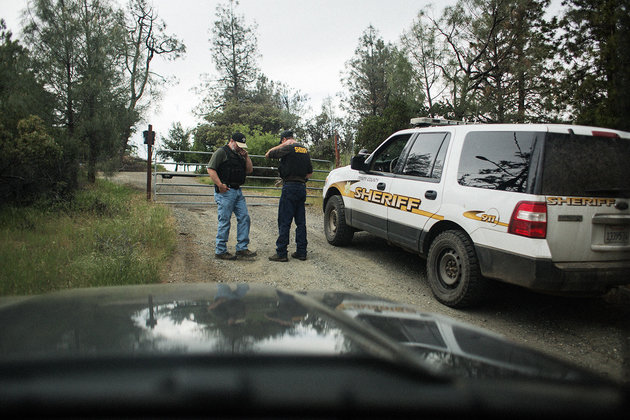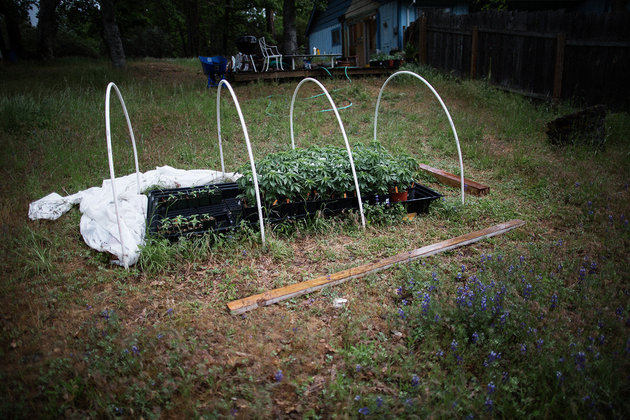Rural Trinity County is home to 13,500 people in Northern California and marijuana production is rampant there. Along with Humboldt and Mendocino counties, Trinity comprises California’s “Emerald Triangle,” a region known for its prolific marijuana farming. Hayfork is Trinity County’s second largest town, and an area of concentrated production.
Trinity has been subject to a series of natural resource economic booms: In the eras before marijuana, both the gold and timber industries thrived in its rugged expanse of mountains. Hayfork in particular was singularly tied to those economies. When the timber business went bust in the early 1990s, Hayfork’s economy tanked. The town, once home to seven timber mills, lost its final mill in 1996, and overnight 160 jobs were lost. Since then, the economy has failed to stabilize.
In the wake of the timber industry’s collapse, many long-time locals turned to marijuana to support themselves, while at the same time early participants in the trade began moving to Hayfork to establish outdoor farms. In Hayfork, a town with no stoplights, no major banks or stores, no resources for higher education, and located two hours from the nearest urban center, the average price per acre of vacant land has skyrocketed from $17,071 in 2005 to $33,350 in 2015. Current property listings for undeveloped 1.5 acre parcels range from $75,000 to $150,000, breaking down to a value of $50,000 to $100,000 per acre.
The passage of Proposition 215 in 1996 introduced a legal gray area that allowed for the use and cultivation of medical marijuana under state law, but didn’t provide a regulatory framework for sales, production, distribution or even qualification for medicinal use. In this quasi-legal context, the risk of producing and selling was reduced, and many people began growing — some for medicinal uses and some to sell on the black market for income. Two decades later, California’s cannabis industry is estimated to be worth billions. In the Emerald Triangle, where the industry was already present, marijuana has become a prevalent economic force, with growers taking advantage of the opportune convergence of inexpensive land, good growing conditions and significantly reduced legal exposure.
The local sheriff’s department estimates there are 2,000 individual, private marijuana “grows” in Hayfork, a town with a population of about 2,500. Cultivation is both obvious and prevalent: It doesn’t take much effort to spot the many marijuana gardens within its boundaries — they are plainly visible from most roads in town, cropping up in backyards and behind fences. A windshield survey recently counted 42 observable cannabis gardens along a 7.2-mile stretch of Highway 3, the main route through town.

Local bulletin boards are plastered with requests for marijuana work, complete with phone numbers and promises of discretion and trustworthiness. Notices posted in the local laundromat tell customers they aren’t allowed to wash clothes dirtied with marijuana, and exasperated warnings in some bars state that patrons aren’t allowed to smoke weed on the premises, while acceptance is taken for granted in other establishments, whose patrons get high on decks and patios outside. Conversations about the industry — troubleshooting pests and molds, the realities of the marijuana market, run-ins with law enforcement– are commonly overheard and easily shared, even with strangers.
By common consensus, the cannabis industry is Hayfork’s primary economic driver. In 2015 an informal survey of the town’s workforce counted just 424 jobs, leaving self-employment options or commutes to work outside town as the next alternatives. Extensive interviews with law enforcement agencies and multiple residents suggest that a majority of townspeople are involved in the industry, and many — perhaps most — are producing and selling illegally. In this rarefied context, participation in the black market is an integrated component of life and culture. In Hayfork, marijuana farming has become the new normal.
The prevalence of Hayfork’s marijuana industry has been uniquely shaped by economic hardship. The polar ends of the trade — law enforcement and small-scale black market marijuana farmers – share a common relationship to marijuana that is defined by financial strife. On one side, a significant funding handicap has stymied law enforcement, allowing the marijuana industry to proliferate; on the other, poverty, economic struggle and a lack of alternatives have provided an incentive for many locals to dive into the black market.
(Note: Some names and identifying characteristics have been changed for this article.)
Mary is a mother in her 30s who is a part-time working professional and also grows and sells marijuana. Like many marijuana farmers, she straddles legal and illegal activity – producing marijuana under nebulous state law, and selling it on the black market. A Northern California native, she eventually purchased a home in Trinity County in 2009 and began farming shortly afterward.
“I hadn’t planned on farming,” she says, “but when I assessed the reality of my situation, as a single person working part time, when I started really looking at my costs living here, it was clear that I would need something to supplement my income a little bit. In the first couple years [marijuana] basically just paid for property improvements. It paid for things that would pop up and take a couple of grand that I wouldn’t have in savings. It helped pay my mortgage.”
Since then, Mary has maintained an outdoor cannabis garden that produces an annual crop harvested in the fall. She deliberately keeps her garden small, never cultivating more than 15 plants, a strategy she has adopted to minimize her risk in a morass of incomplete and evolving regulations. Mary’s earnings from her comparatively small garden have typically fallen between $5,000 and $10,000 a year. Now she has a partner, Sam, who works in construction and carpentry, and they have a 3-year-old daughter. Mary earns about $23,000 a year at her job and Sam does piecemeal work landscaping, logging and at construction gigs. They are continuing a small-scale farm to help them generate funds to develop a construction business for Sam, a move they hope will offer them long-term financial stability.
The money from their garden will be used to purchase start-up equipment such as tools and reliable transportation. Without this income helping to build a local business, Sam would have to travel for work, which would make childcare difficult and also put a strain on the family.
“I just need one more good year [of farming marijuana] and I won’t need to do that garden ever again,” Sam says. “But a new truck right now will be helpful.”
Mary is just one of many everyday people who are dipping into California’s weed trade. Now a vast network, much of the industry is supported by those who have turned to marijuana farming to support themselves, supplement their income or alleviate financial struggles. Marijuana growers are retirees, college graduates, single parents, teachers and many others with legitimate jobs or a lack of better alternatives.
The California Growers Association, a marijuana farmer advocacy group, calculates that there are at least 40,000 independent, private-land marijuana grows in California that provide an estimated 250,000 jobs. In many rural communities like Hayfork, where poverty and unemployment are high, marijuana has become a significant source of work.
“For the last 40 years this product has been the backbone of rural California,” says Hezekiah Allen, CGA’s executive director. “This really is the product that keeps a lot of families fed, quite frankly. Rural California is not an affluent place.”
In Hayfork, underdevelopment has simultaneously limited alternative employment options and tax-based sources of funding. Trinity County has a large amount of federal and state-owned land (about 75 percent) and a low population base, meaning that property and sales tax revenues are dismally low, and state funding allocations, typically based on population, are limited as well. The result is that county services and law enforcement are underfunded, and economic growth is stunted by isolation and limited development space. The few job options in Hayfork outside the marijuana industry generally don’t pay competitive wages. Currently about a quarter of the population lives in poverty.
The funding realities of the Trinity County Sheriff’s Department are bleak. Its budget supports only eight deputies. “We don’t have enough staff to man the county 24 hours a day, seven days a week, which is the norm every place else,” says Sheriff Bruce Haney. “The last time we had 24/7 coverage was in 1994.”
This means there are times when no active officers are on duty throughout the entire county. If there is an emergency call, an officer will be dispatched from his home, adding delay when response time can already be quite lengthy (commutes between communities can be as long as three hours). It also means that the department routinely enters into dangerous situations understaffed. “On a normal domestic violence call,” explains Deputy Omar Brown, “there would be five officers, but we will answer domestic violence calls with only one officer.”
This lack of personnel also limits the department’s ability to gather evidence needed for prosecutions. “Legal surveillance, for example, requires 24-hour coverage, but we don’t have enough deputies to man a surveillance post for 24 hours,” Brown says. To offset these staffing gaps, the sheriff’s office requests support from other enforcement agencies, such as the Forest Service or California Highway Patrol to assist with raids or arrests — a system that is far from adequate or reliable, since these agencies generally can’t plan and schedule this kind of partnership effort in advance.
Anticipated shifts in the status of marijuana as a drug are even impacting enforcement funding– Haney reports that additional funding for marijuana enforcement, such as grants, has become less available because of the uncertainty of regulation and of pot’s legal status.
“Cannabis Eradication is a slowly diminishing source of funding,” says Haney, “and those grants come with strings. It ties our hands to a point. We need guys that can be out patrolling, not going to 10 meetings throughout the state, or tied to specific outcomes. They are not where our focus needs to be.”
The department also struggles to offer competitive salaries, which makes recruitment and retention of personnel challenging. Starting wages for a sheriff’s deputy in Trinity County average $16 per hour, or about $30,000 per year, far lower than typical pay rates, which range between $58,000 and $96,000 annually.
“It’s hard to get deputies to come work here,” says Brown. “And when they are here it’s hard to keep them.”
The stark reality is that it’s impossible for eight deputies to take on thousands of marijuana grows. Already struggling with capacity, the department is also tasked with handling other criminal activity such as murder, theft and robbery. Marijuana is not always a priority, and the ongoing lack of marijuana enforcement has created a perception of relative lawlessness.
As a result, marijuana cultivation has become a creeping issue for the sheriff’s department. Not only are more people farming, but their gardens are bigger. Many are attracted to the promise of profit, but the growing popularity of cannabis production has also created a supply glut that is driving down prices. While black market prices vary, local growers report significant drops in price. A pound that once netted $4,000 now sells for around $1,200 and sometimes as little as $800. This drop in profitability has caused many to increase their production to offset falling prices.
“There are big grows and small grows, but the average is 150 to 200 plants,” says Deputy Brown. “If we had had [more resources] 10 years ago we would be looking at 36-plant grows.”
Brown notes that even if funds were now more readily available, production is so rampant that effective management doesn’t seem like a viable outcome, a sentiment echoed by others in the department.
“I think we [have] probably reached a point where it’s impossible to get it under control,” says Deputy Chris Compton. “Even with a staff of 20, it would take us years and years and years and years.”

lifornia is forging a regulatory path for its gray market marijuana industry, but there are still many undecided variables. In 2015 California passed legislation to regulate the medicinal marijuana industry but the permitting, licensing and fee systems won’t be finalized until 2018, and counties have the authority to develop their own cultivation ordinances as well. Additionally, the state passed a regulatory framework for medical marijuana in 2015, and Proposition 64, the Adult Use of Marijuana Act (AUMA), a new initiative to regulate recreational marijuana, will be on this November’s ballot, potentially introducing yet another bureaucratic layer. These new regulations will shape the future of the industry, and in many ways will define who will be able to legally farm marijuana.
While marijuana regulation will bring potential benefits, such as tax revenue, environmental protections and a regulated end product for the consumer, the accumulating costs of legitimacy could wall out the small-scale players, and the full economic impact of this remains unknown. The costs and particulars of California’s newly adopted medical marijuana regulatory system are still being decided, but expenses can be high—in Colorado fees vary widely depending on size and business set up, but can beupwards of $20,000, and in New York licensing fees add up to $210,000. Entry into the legitimate industry will include multiple fees payable to counties and states, as well as costs to product-testing facilities and distributors. Outdoor farmers, like Mary and Sam, will also have land and water regulations to contend with, such as the State Water Board’s cannabis compliance program,and county and agency regulations.
As more states legalize and the industry continues to boom, there is increasing competition both within and between the legitimate and illegal markets. The numerous existing marijuana cultivators are left to test the viability of the emerging legitimate industry as entrepreneurs, weather the black market or do both.
Jacob and Jen are a couple that have been growing marijuana to sustain themselves financially for almost 30 years, beginning when they lived in the Bay Area.
“I was line cooking, and [Jen] was working retail,” Jacob says of their pasts. “We were both coming to the end of our ropes. I couldn’t keep line cooking — it was horrible for my health. We were both making 10 to 12 bucks an hour and paying $800 a month rent. So we started growing enough to sustain our household.”
The pair maintained a small indoor marijuana grow in their Berkeley apartment in the 1980s and saved the profits until they could afford to purchase a plot of land in Trinity County, where they began growing on an outdoor farm.
“It was really poor in the beginning,” Jacob says of the early days of farming. “We made about $15,000 to $20,000, gross. We went up from there. The first year we did good – we had 40 pounds and they probably went for $2,000 a pound. We paid off our land and our debts. But that’s still just an income for two people.”
Jacob and Jen have continued farming to support themselves, but their operations have remained small; last year they produced 70 pounds that grossed $60,000. After decades of marijuana growing, they find themselves in a tenuous position, working to stay afloat in an uncertain and cutthroat market where a cannabis surplus has lowered prices.
Like many who have relied on the black market industry for their primary source of income, Jacob and Jen have few alternatives that would provide for them. “I have literally no idea what else I would do [if I wasn’t farming],” Jacob says. “Aging out of the workforce is a problem. I probably couldn’t get hired at a restaurant now, and [even if I did] I wouldn’t like it.”
Trinity County’s law enforcement and marijuana producers are living in a time of questions. The sheriff’s department remains limited in its capacity, and many small-scale farmers like Jacob and Jen, and Mary and Sam, face uncertainty about their livelihoods. The outcomes for both sides, tightly wed to economic viability, will manifest in the fallout of regulation – the emerging determiner that will decide what marijuana farming will look like for growers, enforcers and Hayfork alike.
- Publish my comments...
- 0 Comments
